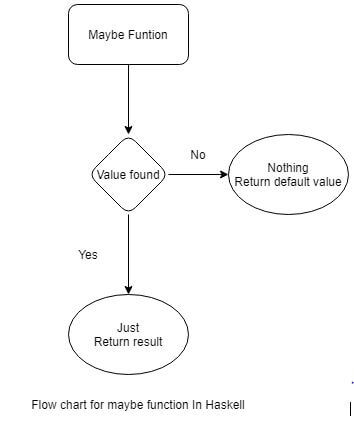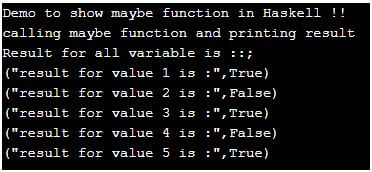Updated April 20, 2023
Definition on Haskell maybe function
In Haskell we have maybe a function to deal with optional values, this function is mainly used to check whether the maybe type contains a value or not. This function is very useful when we want to deal with error and exception, this function can prevent occurring several exceptions and errors if the value if not present in the maybe type. It has two keywords associated with it that is ‘Just’ and ‘Nothing’, depends upon the value it returns on checking the maybe type value. In the coming section of the tutorial, we will discuss more the internal implementation, working, and its usage in detail for better understanding and start using it while making any check writing the program in Haskell.
Syntax:
As we discussed already that it will either contain a value or nothing at all. Let’s take a look at its syntax before using it while programming, see below;
data Maybe a = Just a | NothingAs you can see in the above lines of code this function has two things with it first is Just and another one is Nothing, this is the basic definition of maybe function given by the Haskell documentation. Let’s take a practice syntax how to use it, for beginners to understand its syntax and definition better see below;
e.g. :
maybe default_value predicate (Just your_value)As you can see in the above lines of code, it’s difficult to understand how it works, but in the coming section, we will discuss more its usage in detail.
How does maybe function work in Haskell?
As now we know that maybe function mainly checks whether the value present or not. It has two constructors named ‘Just’ and ‘Nothing’. Let’s take a look at its constructors in details how they work to check the value of type maybe, using function maybe in Haskell see below;
Constructors:
1) Just: Just represent if the value is present inside the value of type maybe. If it found it true then it will return us the value.
2) Nothing: Nothing represents if the value is not present inside the value of type maybe. If it is not able to find the value then it will return us the default value or return nothing.
In Haskell we use maybe a function to deal with the optional value present inside the variable, this helps us from error and exception because while programming we are not sure what value s going to hold in the variable. We are also not sure if it contains the value or it just blank or null. This type of situation can be avoided by using maybe function in Haskell while programming. Let’s take look at its flow how it internally works. A step which is carried out while execution of the maybe function in Haskell see below;
1) We can use maybe keyword to call or use maybe function in Haskell. Note it is an in-built function in Haskell we do not require to install or once any external dependency for this function to be used while programming.
2) While using this function we assign one default value that we want to print or return. If the value if present it will use the Just constructors here. It will return the value.
3) if the value is not present it will just return us the default value or nothing in return.
4) It evaluates the value based on Just and Nothing. we can use predicate here also.
5) After all this it will just return out of the program with applicable value.
Below see flow chart;
Let’s take a simple program to understand how it works, this will help beginners to understand its implementation in detail, also they can start using this while programming see below;
e.g.:
maybe False odd (Just 10)As you can see in the above lines of code we are trying to use maybe the function was with an odd predicate. So it will try to calculate the value whether it is odd or not. If the value is present then it will return true or false based on the evaluation that happened using an odd predicate. If the value is Nothing then it will return us the default value as the result. this function is very easy to handle and maintain.
Points to be remembered while using maybe function in Haskell see below;
1) It is an in-built function in Haskell.
2) It will check either value present in the maybe value type or not.
3) To represent any value it uses Just, and to represent a nothing it uses ‘Nothing’.
Example
1) In the below example we are trying to use the maybe function to return result if the value is presently using the Just from maybe function in Haskell. This is a sample example for beginners to understand better.
Code:
main = do
putStrLn "Demo to show maybe function in Haskell !!"
putStrLn "calling maybe function and printing result "
let value1 = 1
let value2 = 2
let value3 = 3
let value4 = 4
let value5 = 5
putStrLn "Result for all variable is ::;"
let result1 = maybe False odd (Just value1)
print("result for value 1 is :", result1)
let result2 = maybe False odd (Just value2)
print("result for value 2 is :", result2)
let result3 = maybe False odd (Just value3)
print("result for value 3 is :", result3)
let result4 = maybe False odd (Just value4)
print("result for value 4 is :", result4)
let result5 = maybe False odd (Just value5)
print("result for value 5 is :", result5)Output:
Conclusion
By using maybe function we can overcome so many errors and exception which can occur at runtime. Here we are providing a prior check to the code whether it contains a value or not. After that, only everything else will be executed and it will save time as well. For developers, it is very easy to use, readable and maintainable as well.
Recommended Articles
We hope that this EDUCBA information on “Haskell maybe” was beneficial to you. You can view EDUCBA’s recommended articles for more information.




